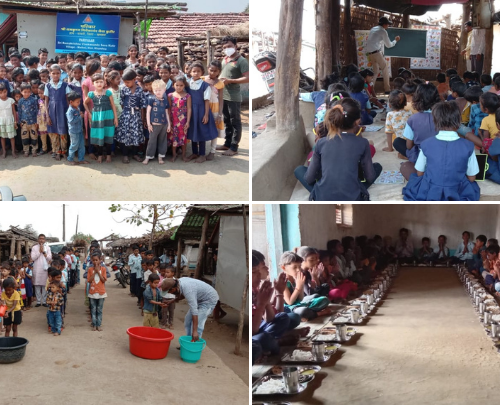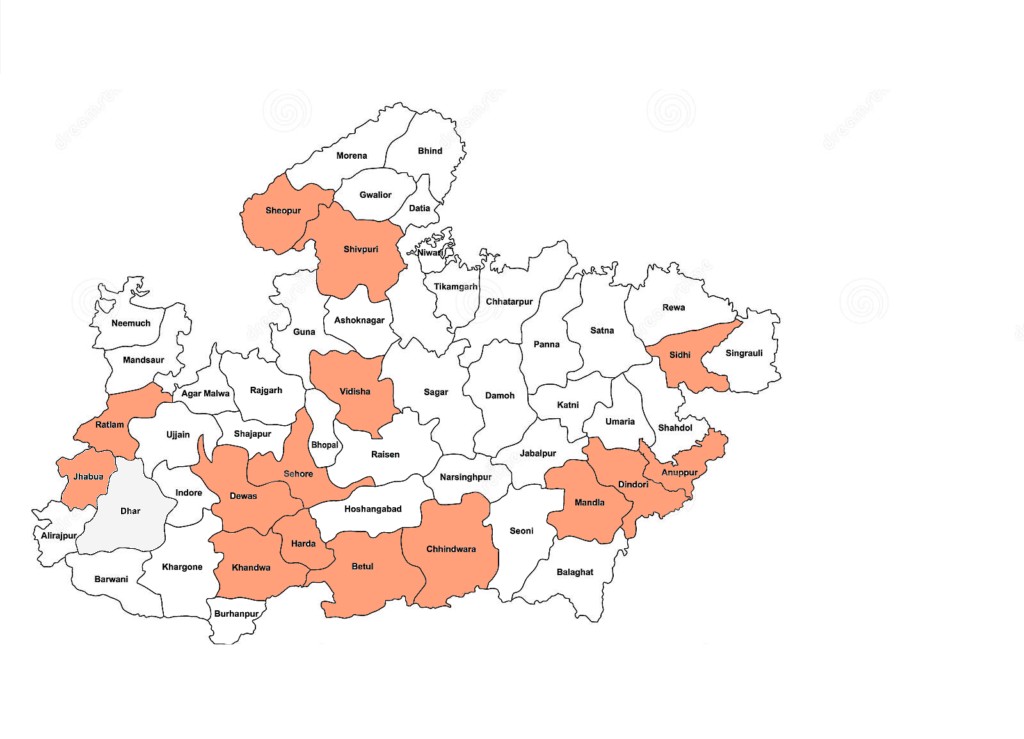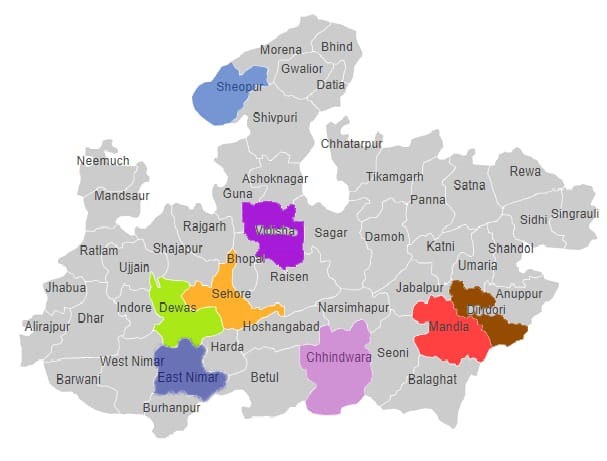

| S.No | District | Number Of Seva Kutirs |
|---|---|---|
| 1 | Sheopur | 143 |
| 2 | Chhindwara | 100 |
| 3 | Betul | 68 |
| 4 | Dindori | 60 |
| 5 | Khandwa | 55 |
| 6 | Dewas | 45 |
| 7 | Sehore | 41 |
| 8 | Anuppur | 38 |
| 9 | Mandla | 30 |
| 10 | Shivpuri | 28 |
| 11 | Sidhi | 18 |
| 12 | Ratlam | 14 |
| 13 | Harda | 14 |
| 14 | Vidisha | 7 |
| 15 | Jhabua | 4 |
| Total | 665 |

| S.No | District | Number Of Seva Kutirs |
|---|---|---|
| 1 | Dewas | 45 |
| 2 | Sehore | 42 |
| 3 | Mandla | 30 |
| 4 | Sheopur | 71 |
| 5 | Chhindwara | 30 |
| 6 | Khandwa | 30 |
| 7 | Vidisha | 7 |
| 8 | Dindori | 6 |
| Total | 261 |

In January ’18, The Economist had a cover article on India titled “India’s missing middle class” which had a chilling statistic- Poor diets mean that 38% of children under the age of five are so underfed as to damage their physical and mental capacity irreversibly, according the Global Nutrition Report. The comparable number for Sub-Saharan Africa is apparently lower at 35%. India has the largest number of stunted children in the world, at 48.2 million. In the state of Madhya Pradesh more than 60% children are malnourished. In some impoverished tribal areas of Madhya Pradesh it is as high as 90%.
While the enrolment rate in government schools across the country in the age-group of 4 to 14 has increased to more than 97%, the learning outcomes in the specially deprived tribal pockets which are marked by first-generation learners have remained dismal as shown by many reports like the ASER. While the ‘No Detention Clause’ in the ‘Right to Education Act’ coupled with the Mid-Day-Meal Program in Government Schools has ensured that children continue to be enrolled in the Schooling system till age of 14 (Grade 8), there is no effective continuous measurement of learning outcomes. Moreover with government schools running for not more than 150 – 175 days, there is need for alternate supplementing spaces for ensuring better learning, socialization, development of world-view, and civic virtues coupled with value education to the children as they grow up. The Seva Kutirs combines two key themes most crucial for children in interior rural areas in the country – malnutrition and education.
The Seva Kutirs have the following design features:
1. Village Community Provided Venue :
The village community has to invite us and offer a venue free. Usually it is somebody’s house, Panchayat building, community hall, school in its non-functioning hours, or even a shed / godown. Thus we do not incur any infrastructure costs for this.
2. Morning (Breakfast) and Evening (Dinner) Shifts :
Most Kutirs follow a 2-shift engagement with the children (from morning 7 to 10:30 and from 4 to 7:30). In the morning shift breakfast, with seasonal fruits and milk are given, and dinner (roti, sabzi, rice and dal) is served in the evening shift. During day-time the children are sent to the local Government school so that a continued engagement is established with them. The Seva-Kutirs are aimed at complementing the government schooling and not act as a substitute. But it has much more emphasis and inputs both nutritionally as well educationally.
3. Local Human Resources :
To the extent possible we engage all local workforce (cooks, helpers are from the same village) and teachers from the same or nearby area.
4. The Kutirs in the same area are organised under one cluster.
5. Central Resource Team :
i. Education : Resource persons experienced in pedagogy, teacher training, and curriculum design ensure planning and uniform implementation across Kutirs. They also perform a continuous Impact Assessment of Kutirs to encourage constant improvement of the programs. Sports, Value Education, and Civic Virtues are also components of the Kutirs.
ii. Nutrition and Health : central Resource persons specialising in nutrition supervise the delivery of our meals and supplementary dietary inputs to children with severe malnourishment. They also work in sync with Nutrition Resource Centres in government hospitals. They do a continuous assessment of various indicators of health and nutrition for children across the Kutirs.
6. Community ‘buy-in’ in the program:
The program is designed carefully to involve people not just as beneficiaries but as stake holders. Institutions like Panchayats and non Government bodies like self- help groups, women- led federations which have seen a growth in tribal areas are being reached out to and is involved in the processes of the program like:
Mobilizing children in villages for the Seva Kutir
Volunteering for the Seva Kutir
Regular sharing of data on the children of their villages on health and education
Mobilizing action to achieve success in convergence with government programs.
7. Stress on Local Supply :
To the extent possible, we are procuring vegetables, milk etc from local suppliers. We are encouraging the poor village communities to produce whatever is necessary for the Seva Kutirs locally. Towards this we will, with help of external agencies, also help and facilitate the local communities to organise themselves into producer groups / organizations
 Program progress
The following table will give you an overview of all the educational inputs that go into running a single Kutir.
Program progress
The following table will give you an overview of all the educational inputs that go into running a single Kutir.
 MONITORING AND EVALUATION
MONITORING AND EVALUATION

The whole concept of Seva Kutir was built on the premise of complementing the existing government systems and schemes. The nutrition aspect that the Seva Kutirs have undertaken is to complement the mid day meal scheme by providing nutritious food for the remaining two meals, i.e. breakfast and dinner. Educationally the Kutirs by holding sessions with government school children in the morning and evening slots (after and before school) aim to assist the children in their school curriculum by making children over 7 years grade ready and under 7 years school ready.
Education:
Sharing data: Sharing of baseline and progress data with local schools and also district authorities in regular intervals of 3 months.
Mutually designed curriculum: We are already in discussions with district school authorities regarding our work in Kutirs we have shared our curriculum with them each month. We will be doing so with the teachers in the schools that the Kutir children attend and also ask them feedback and where they require help from us specific to some subjects. In informal discussions with some such teachers they have asked us to particularly focus on Maths and Science since many drop outs in the region are because of inability to understand these two subjects.
Upgrading teaching methodologies: We hold trainings for our Kutir teachers every month; we are going to propose to district education authorities if their teachers from the villages (where Kutirs are) can participate as well.
Kutir space and collaborative social action by children: Many of our Kutirs are right now in personal homes or community / government spaces given by the villages. We are soon holding visioning exercises with our children regarding Kutir and village as a whole on how they would like their village & Kutir to look like and then these children will present it to Gram Sabhas. Also to enhance their agency of social action and civic responsibility we are going to make them regular participants in Gram Sabhas.
Nutrition:
Sharing data: Sharing of baseline and progress data with anganwadis, hospitals and child and health department and collaboration for appropriate action like taking a child to NRC etc.
Sharing and feedback menu: We are trying to see how we can complement the mid day meal scheme better by talking to local authorities on our menu for each month.
Collaborating with anganwadi workers and Asha workers in ensuring proper medical attention to the needy children and mothers.
Local Agriculture and Horticulture:
We are promoting local cultivation by assuring to buy from the village itself which will help such areas in moving from sustenance farming to commercial farming. We are sharing such plans with agriculture department and are seeking their support on technical and input side. Some of the saplings of Munga or Moringa that we are growing in Kutirs have been given by the agriculture department. We are also in discussion with external agencies in developing kitchen gardens (including green vegetables, peas etc) and plantation of fruit trees (which will be impactful in the long-run for the local villages).
Average costs per child in a Seva Kutir is around Rs 12,500.
For a 80 children Seva Kutir the costs would be around Rs 10 Lacs.
For a 100 children Seva Kutir the costs would be around Rs 12.5 Lacs.
Seva Kutir Sponsors :
Each of the following have sponsored one or more Seva Kutirs in Madhya Pradesh.
Individual Donors :
1. Ashish Kacholia Mumbai
2. Vallabh Bhansali Mumbai
3. Shyam Maheshwari Singapore
4. Chetan Shah Singapore
5. Sameen Farooqui Singapore
6. Ravikiran Mankude Singapore
7. Rajesh Raman Singapore
8. Vishal Shah Mumbai
9. Tejinder Miglani Delhi
10. Sudhakar Ram Mumbai
11. Pranav Thakur UK
12. Kamayani Shukla Singapore
13. Ambarish Malpani USA
14. Sashi Reddy Singapore
15. Ashutosh Sinha Singapore
16. Alok Agarwal Mumbai
17. P.D. Mundra Mumbai
18. Anoop Maheshwari Mumbai
19. Dhawal Mehta Singapore
20. Rohit Sobti Singapore
21. Mohit Gupta Gurgaon
22. Kanchana Gupta Singapore
23. Ranodeb Roy Singapore
24. Debashish Duttagupta Singapore
25. Vikas Agarwal Singapore
26. Suren Mansingka USA
27. Alka Aggarwal USA
28. Mohit Malhotra Mumbai
29. Utpal Sheth Mumbai
30. Sunil and Anil Devnani Mumbai
31. KK Maheshwari Mumbai
32. Sanjay Agarwal Kolkata
33. Prakash Narayan UK
34. Neil Bhalodkar USA
Trusts / Foundations :
1. Sachin Tendulkar Foundation
2. N.M. Budhrani trust Mumbai
3. Jai Shiv Shakti Trust Bangalore
4. Amit Chandra Foundation
5. Govindram Seksaria Trust Indore
6. Sar-La Trust Mumbai
7. Lal Family Fondation
8. Asha for Education
9. Young Volunteers Organization Mumbai
Companies (CSR Grants) :
1. Infosys Foundation
2. HDFC Asset Management Company
3. Fine Organics Mumbai
4. East India Securities
5. Capri Global Mumbai
6. AAK Kamani Mumbai
7. Polycab Ltd Mumbai
8. Future Group Mumbai
9. Shapoorji Pallonji Finance Mumbai
10. Alkem Laboratories
11. Sarda Minerals Ltd Raipur
12. Advanced Enzyme Technologies Ltd Mumbai
13. Umang Pharmatech Mumbai
14. Sharda Cropchem Mumbai
15. Nucleus Software Ltd Noida
16. Himgiri Castings
© 2021 All rights reserved